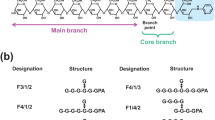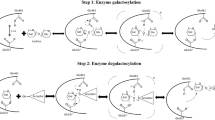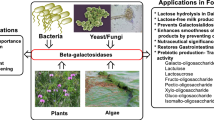Abstract
Cellulase 12A from Thermotoga maritima (TmCel12A) is a hyperthermostable β-1,4-endoglucanase. We recently determined the crystal structures of TmCel12A and its complexes with oligosaccharides. Here, by using site-directed mutagenesis, the role played by Arg60 and Tyr61 in a unique surface loop of TmCel12A was investigated. The results are consistent with the previously observed hydrogen bonding and stacking interactions between these two residues and the substrate. Interestingly, the mutant Y61G had the highest activity when compared with the wild-type enzyme and the other mutants. It also shows a wider range of working temperatures than does the wild type, along with retention of the hyperthermostability. The k cat and K m values of Y61G are both higher than those of the wild type. In conjunction with the crystal structure of Y61G–substrate complex, the kinetic data suggest that the higher endoglucanase activity is probably due to facile dissociation of the cleaved sugar moiety at the reducing end. Additional crystallographic analyses indicate that the insertion and deletion mutations at the Tyr61 site did not affect the overall protein structure, but local perturbations might diminish the substrate-binding strength. It is likely that the catalytic efficiency of TmCel12A is a subtle balance between substrate binding and product release. The activity enhancement by the single mutation of Y61G provides a good example of engineered enzyme for industrial application.




Similar content being viewed by others
References
Al Balaa B, Brijs K, Gebruers K, Vandenhaute J, Wouters J, Housen I (2009) Xylanase XYL1p from Scytalidium acidophilum: site-directed mutagenesis and acidophilic adaptation. Bioresour Technol 100:6465–6471
Bhat MK (2000) Cellulases and related enzymes in biotechnology. Biotechnol Adv 18:355–383
Birsan C, Johnson P, Joshi M, MacLeod A, McIntosh L, Monem V, Nitz M, Rose DR, Tull D, Wakarchuck WW, Wang Q, Warren RA, White A, Withers SG (1998) Mechanisms of cellulases and xylanases. Biochem Soc Trans 26:156–160
Blumer-Schuette SE, Kataeva I, Westpheling J, Adams MW, Kelly RM (2008) Extremely thermophilic microorganisms for biomass conversion: status and prospects. Curr Opin Biotechnol 19:10–217
Bornscheuer UT, Pohl M (2001) Improved biocatalysts by directed evolution and rational protein design. Curr Opin Chem Biol 5:137–143
Böttcher D, Bornscheuer UT (2010) Protein engineering of microbial enzymes. Curr Opin Microbiol 13:274–282
Brunger AT, Adams PD, Clore GM, DeLano WL, Gros P, Grosse-Kunstleve RW, Jiang JS, Kuszewski J, Nilges M, Pannu NS, Read RJ, Rice LM, Simonson T, Warren GL (1998) Crystallography & NMR system: a new software suite for macromolecular structure determination. Acta Crystallogr D 54:905–921
Cheng YS, Ko TP, Wu TH, Ma Y, Huang CH, Lai HL, Wang AHJ, Liu JR, Guo RT (2011) Crystal structure and substrate-binding mode of cellulase 12A from Thermotoga maritima. Proteins 79:1193–1204
Crennell SJ, Cook D, Minns A, Svergun D, Andersen RL, Nordberg Karlsson E (2006) Dimerisation and an increase in active site aromatic groups as adaptations to high temperatures: X-ray solution scattering and substrate-bound crystal structures of Rhodothermus marinus endoglucanase Cel12A. J Mol Biol 356:57–71
De Lemos Esteves EF, Gouders T, Lamotte-Brasseur J, Rigali S, Frere JM (2005) Improving the alkalophilic performances of the Xyl1 xylanase from Streptomyces sp. S38: structural comparison and mutational analysis. Protein Sci 14:292–302
Dumon C, Varvak A, Wall MA, Flint JE, Lewis RJ, Lakey JH, Morland C, Luginbuhl P, Healey S, Todaro T, DeSantis G, Sun M, Parra-Gessert L, Tan X, Weiner DP, Gilbert HJ (2008) Engineering hyperthermostability into a GH11 xylanase is mediated by subtle changes to protein structure. J Biol Chem 283:22557–22564
Dutta T, Sahoo R, Sengupta R, Ray SS, Bhattacharjee A, Ghosh S (2008) Novel cellulases from an extremophilic filamentous fungi Penicillium citrinum: production and characterization. J Ind Microbiol Biotechnol 35:275–282
Eisenthal R, Danson MJ, Hough DW (2007) Catalytic efficiency and kcat/Km: a useful comparator? Trends Biotechnol 25:247–249
Emsley P, Lohkamp B, Scott WG, Cowtan K (2010) Features and development of Coot. Acta Crystallogr D 66:486–501
Henrissat B, Teeri TT, Warren RA (1998) A scheme for designating enzymes that hydrolyse the polysaccharides in the cell walls of plants. FEBS Lett 425:352–354
Hua C, Yan Q, Jiang Z, Li Y, Katrolia P (2010) High-level expression of a specific β-1,3-1,4-glucanase from the thermophilic fungus Paecilomyces thermophila in Pichia pastoris. Appl Microbiol Biotechnol 88:509–518
Ilari A, Fiorillo A, Angelaccio S, Florio R, Chiaraluce R, van der Oost J, Consalvi V (2009) Crystal structure of a family 16 endoglucanase from the hyperthermophile Pyrococcus furiosus: structural basis of substrate recognition. FEBS J 276:1048–1058
Jarvis M (2003) Chemistry: cellulose stacks up. Nature 426:611–612
Jones TA, Zou JY, Cowan SW, Kjeldgaard M (1991) Improved methods for building protein models in electron density maps and the location of errors in these models. Acta Crystallogr A 47:110–119
Kapoor D, Kumar V, Chandrayan SK, Ahmed S, Sharma S, Datt M, Singh B, Karthikeyan S, Guptasarma P (2008) Replacement of the active surface of a thermophile protein by that of a homologous mesophile protein through structure-guided ‘protein surface grafting’. Biochim Biophys Acta 1784:1771–1776
König J, Grasser R, Pikor H, Vogel K (2002) Determination of xylanase, β-glucanase, and cellulase activity. Anal Bioanal Chem 374:80–87
Lynd LR, Weimer PJ, van Zyl WH, Pretorius IS (2002) Microbial cellulose utilization: fundamentals and biotechnology. Microbiol Mol Biol Rev 66:506–577
Ohmiya K, Sakka K, Karita S, Kimura T (1997) Structure of cellulases and their applications. Biotechnol Genet Eng Rev 14:365–414
Otwinowski Z, Minor W (1997) Processing of X-ray diffraction data collected in oscillation mode. Methods Enzymol 276:307–326
Percival-Zhang YH, Himmel ME, Mielenz JR (2006) Outlook for cellulase improvement: screening and selection strategies. Biotechnol Adv 24:452–481
Pollet A, Lagaert S, Eneyskaya E, Kulminskaya A, Delcour JA, Courtin CM (2010) Mutagenesis and subsite mapping underpin the importance for substrate specificity of the aglycon subsites of glycoside hydrolase family 11 xylanases. Biochim Biophys Acta 1804:977–985
Sandgren M, Gualfetti PJ, Paech C, Paech S, Shaw A, Gross LS, Saldajeno M, Berglund GI, Jones TA, Mitchinson C (2003a) The Humicola grisea Cel12A enzyme structure at 1.2 A resolution and the impact of its free cysteine residues on thermal stability. Protein Sci 12:2782–2793
Sandgren M, Gualfetti PJ, Shaw A, Gross LS, Saldajeno M, Day AG, Jones TA, Mitchinson C (2003b) Comparison of family 12 glycoside hydrolases and recruited substitutions important for thermal stability. Protein Sci 12:848–860
Schülein M (2000) Protein engineering of cellulases. Biochim Biophys Acta 1543:239–252
Selinger LB, Forsberg CW, Cheng KJ (1996) The rumen: a unique source of enzymes for enhancing livestock production. Anaerobe 2:263–284
Sriprang R, Asano K, Gobsuk J, Tanapongpipat S, Champreda V, Eurwilaichitr L (2006) Improvement of thermostability of fungal xylanase by using site-directed mutagenesis. J Biotechnol 126:454–462
Szijártó N, Horan E, Zhang J, Puranen T, Siika-Aho M, Viikari L (2011) Thermostable endoglucanases in the liquefaction of hydrothermally pretreated wheat straw. Biotechnol Biofuels 4:2
Vieille C, Zeikus GJ (2001) Hyperthermophilic enzymes: sources, uses, and molecular mechanisms for thermostability. Microbiol Mol Biol Rev 65:1–43
Viikari L, Alapuranen M, Puranen T, Vehmaanpera J, Siika-Aho M (2007) Thermostable enzymes in lignocellulose hydrolysis. Adv Biochem Eng Biotechnol 108:121–145
Vocadlo DJ, Davies GJ (2008) Mechanistic insights into glycosidase chemistry. Curr Opin Chem Biol 12:539–555
Yang S, Wang Y, Jiang Z, Hua C (2008) Crystallization and preliminary X-ray analysis of a 1,3-1,4-β-glucanase from Paecilomyces thermophila. Acta Crystallogr F 64:754–756
Yang D, Weng H, Wang M, Xu W, Li Y, Yang H (2010) Cloning and expression of a novel thermostable cellulase from newly isolated Bacillus subtilis strain I15. Mol Biol Rep 37:1923–1929
You C, Huang Q, Xue H, Xu Y, Lu H (2010) Potential hydrophobic interaction between two cysteines in interior hydrophobic region improves thermostability of a family 11 xylanase from Neocallimastix patriciarum. Biotechnol Bioeng 105:861–870
Acknowledgments
We thank the National Synchrotron Radiation Research Center of Taiwan and the Shanghai Synchrotron Radiation Facility of China for beam-time allocations and data-collection assistance. This work was supported by grants from the National Science Council of Taiwan (NSC 98-2313-B002-033-MY3 to JRL), the National Basic Research Program of China (2011CB710800 to RTG), and the Tianjin Municipal Science and Technology Commission (10ZCKFSY06000 to RTG).
Author information
Authors and Affiliations
Corresponding authors
Additional information
Y.-S. Cheng and T.-P. Ko contributed equally to this work.
Electronic supplementary material
Below is the link to the electronic supplementary material.
Supp. Movie S1
TmCel12A catalysis in motion. Interestingly, all bound cellobiose molecules in the Y61G crystal, which occupied the −2 and −1 subsites, had the β-anomeric configuration at the reducing end, where the bond cleavage should have taken place, and they should represent the product-like structure. On the other hand, the bound −1 sugar in the previous E134C mutant structures had the α-anomeric configuration, and they should represent the intermediate-like structure. Together with the structure of wild-type TmCel12A–cellotetraose complex, which represents an uncleaved substrate, a composite illustration of the catalytic process is shown here. It is worth noting that every model in this movie actually comes from one of the crystal structures. In other words, they are all real observations. The protein molecules are shown as green worm models and the bound ligand as stick models with white carbon atoms and red oxygen atoms. The movie was produced by using the program PyMOL and the PDB entries 3AMH, 3AMM, 3AMN, 3AMP, 3AMQ, and 3VHN. Five subsites were observed in the substrate-binding cleft of TmCel12A. They are numbered −3, −2, −1, +1, and +2 from the non-reducing end. The double-displacement cleavage occurs between the −1 sugar and the +1 sugar. The substrate is represented by the bound cellotetraose to the wild-type enzyme. After the first nucleophilic attack by Glu134, an intermediate with the α-anomeric configuration in the −1 sugar is produced, and it is represented by several complex structures of the E134C mutant. The cleaved moiety at the reducing end, originally bound to the +1 and +2 sites, departs from the enzyme. Then the second nucleophilic attack by a water molecule takes place, reversing the α-anomer to a β-anomer at the −1 sugar. The product at the non-reducing end is eventually replaced by a new substrate molecule, and another cycle of the catalytic reaction begins. (MOV 906 kb)
ESM 2
(DOC 4583 kb)
Rights and permissions
About this article
Cite this article
Cheng, YS., Ko, TP., Huang, JW. et al. Enhanced activity of Thermotoga maritima cellulase 12A by mutating a unique surface loop. Appl Microbiol Biotechnol 95, 661–669 (2012). https://doi.org/10.1007/s00253-011-3791-4
Received:
Revised:
Accepted:
Published:
Issue Date:
DOI: https://doi.org/10.1007/s00253-011-3791-4




